|
Pictures of Ancient Japanese History
Part First & Part Second
T.H. Asso & Edwin Arnold
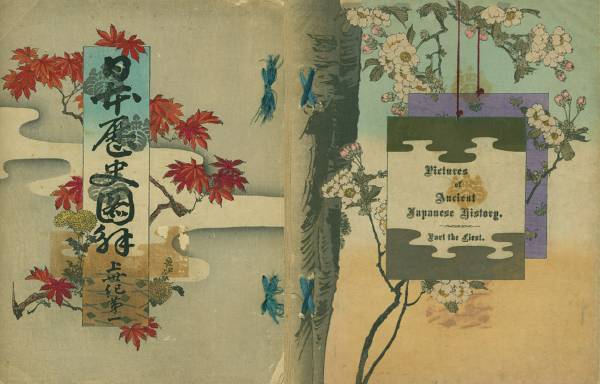
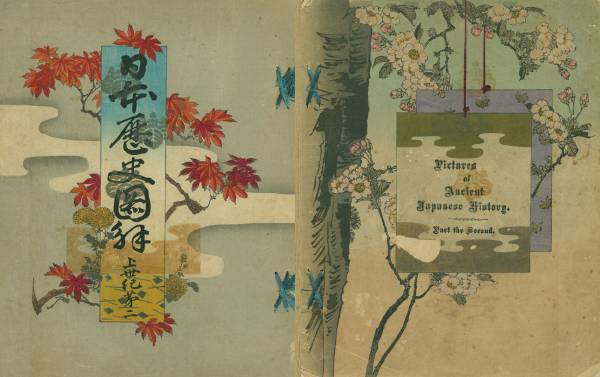
Asso, T.H.
Arnold, Edwin (Revisions):
Pictures of Ancient Japanese History, Part First & Part Second, Tokyo, Z. P. Maruya & Co., 1890 (Meiji 23), 4to (9 1/4 x 11 3/4 in - 23.5 x 29.8 cm ), Japanese and English language text, bound Japanese style with two four hole silk stab ties, color woodblock illustrated covers (front and back) of thick card stock, spine uncovered, reads Japanese style from back to front, 48 black and white illustrations in the text, 98 pages of text (Part I, 50 pages and Part II, 48 pages). Each book contains 24 numbered sections on famous people, historical topics and important events. On the right side page the text is in Japanese and there is a one quarter page illustration at the top. On the left side page the text is in English.
Complete titles.
- Part I. Pictures of Ancient Japanese History, From the coronation of the Emperor Jimmu to the rebellion of Masakado and Sumitomo, Part the First, by T.H. Asso, Chief Inspector of Machinery, H.I.J.M.N., Revised by Sir Edwin Arnold, K.G.I.E., C.S.I., chapters I-XXIV.
- Part II. Pictures of Ancient Japanese History, From the evil doings of Fujiwara to the battle of Dan-no-ura, Part the Second, by T.H. Asso, Chief Inspector of Machinery, H.I.J.M.N., Revised by Sir Edwin Arnold, K.G.I.E., C.S.I., chapters XXIV-XLVIII.
Collation. Front cover with title in English, Japanese colophon, English title page, 24 sections (2 pages each), Japanese title page protected by tissue guard, back cover with title in Japanese. Part I contains two additional pages. One in Japanese and one in English. The English page is titled "The Emperor's Breakfast."
The two parts were published on different dates (June & July, 1890).
Part I. Meiji 23 (1890).6.12
Part II Meiji 22 (1890).7.26
Wenckstern describes the book in these terms:
Asso, I. H. Pictures of ancient Japanese history, Japanese text (in Chinese characters) with English translation revised by Sir E. Arnold, in 2 parts, 96 pp. with coloured illustrations, 4to, Tokyo, 1890. (Wenckstern, Part I, page 95).
It is possible this books were issued in two formats. One with black and white illustrations. The other with internal color illustrations as noted by Wenckstern. I have found one instance where the book described in a library holding with "Hand-coloured illustrations."
Part I.
Colophon
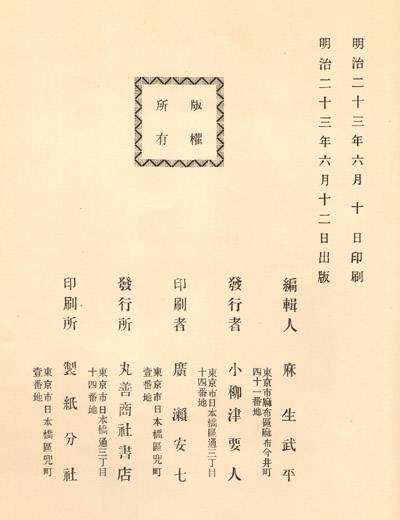
Meiji 23 (1890).6.12
English Title Page
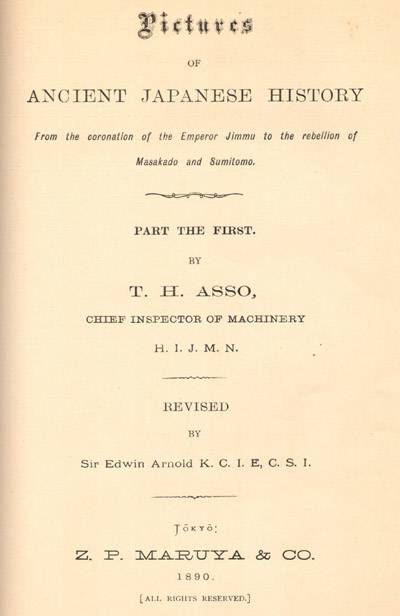
Representative Pages

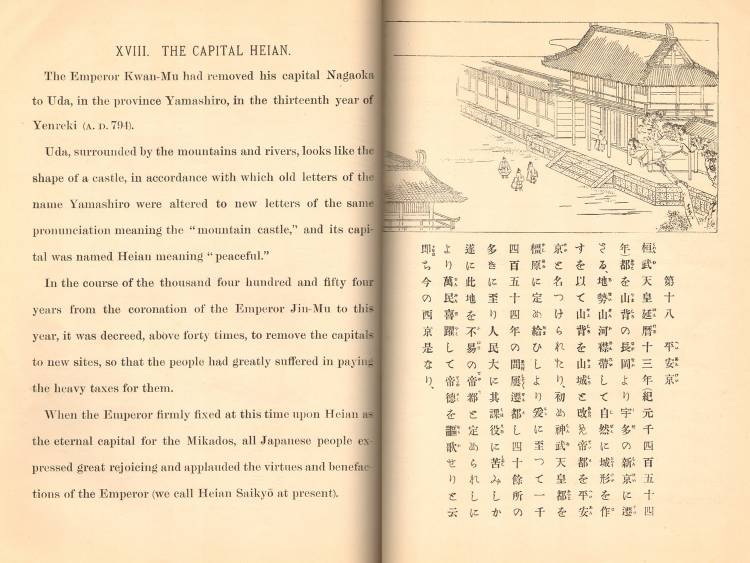
Japanese Title Page

Part II.
Colophon
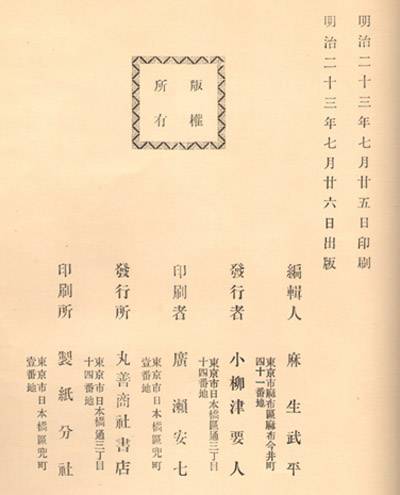
Meiji 22 (1890).7.26
English Title Page
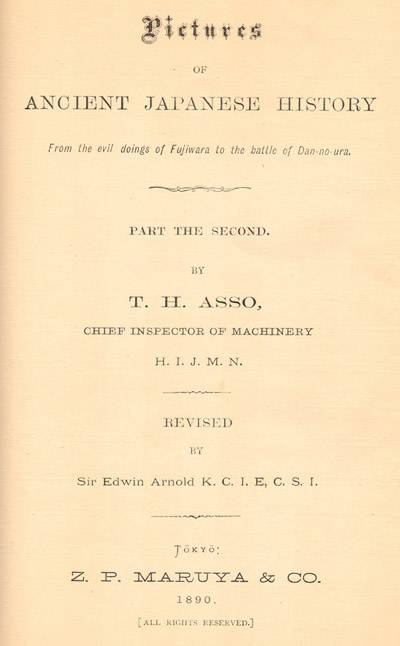
Representative Pages
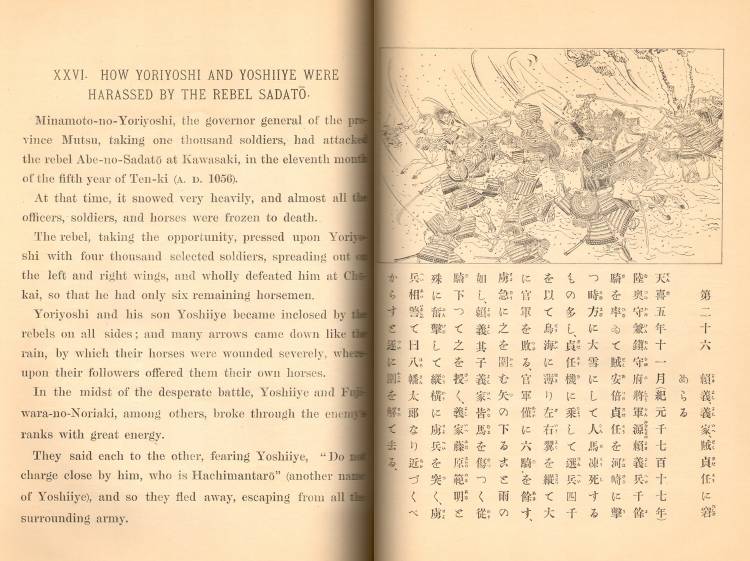

Japanese Title Page
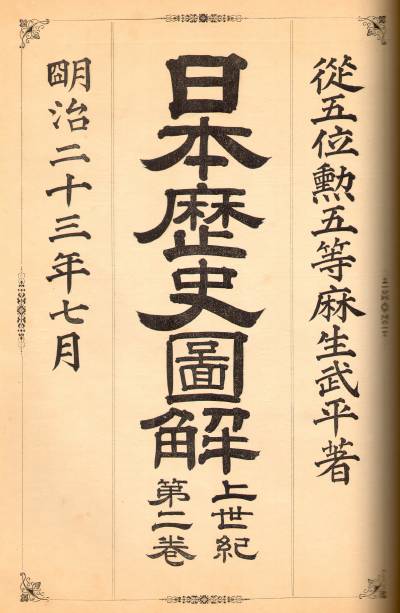
"Part The First."
The Emperor's Breakfast.
I. Coronation of the Emperor Jimmu.
II. Rebellion of Yasuhiko.
III. Rebellion of Saohiko.
IV. Beginning of Wrestling.
V. How Prince Yamatoke-no-Mikoto Crushed the Rebels of Suruga.
VI. How Tachibana-Hime Jumped into the Rough Sea.
VII. The Subjection of Korea by the Empress Jingu.
VIII. Beginning of Chinese Literature in Japan.
IX. The Humane Administration of the Emperor Nintoku.
X. The Brave and Magnanimous Character of the Emperor Yu-Ryaku.
XI. The Introduction of Buddhism into Japan.
XII. How Soga-no-Umako Slew the Emperor Shu-Shun.
XIII. How the Prince Naka-no-Oye Killed Soga-no-Yemiji and Iruka.
XIV. The Mikado's Reforming Ancestor.
XV. The Revold of Jin-shin.
XVI. The Emperor Shomu's Devotion to Buddism.
XVII. Wage-no-Kiyomaro.
XVIII. The Capital of Heian.
XIX. How the Priest Kukai Invented the Forty-Seven Japanese Characters
of I, Ro, Ha, Etc.
XX. The Filial Piety of the Daughter of Tachibana-no-Hayanari.
XXI. Sugawara-no-Michizane.
XXII. The Rebellion of Masakado and Sumitomo.
XXIII. How Masakado was Crushed.
XXIV. How Sumitomo Came to Be Killed.
"Part The Second."
XXV. The Profligacy of the Successive Generations of Fujiwara.
XXVI. How Yoriyoshi and Yoshiiye Were Harrassed by the Rebel Sadato.
XXVII. The intelligence and Power of the Emperor Go-Sanjo.
XXVIII. How Yoshiiye Perceived the Ambush.
XXVIX. How Kiyomori and Sigemori Came Back from Kumano Road.
XXX. How Kiyomori Took the Emperor from the Hands of the Rebels.
XXXI. How Kiyomori Put on his Helmet Backwards.
XXXII. How Yoritomo Came to be Exiled to Itsu.
XXXIII. How Osada-Tadamune Slew Yoshitomo.
XXXIV. Ushiwakamura.
XXXV. How Minamoto-no-Tametomo Sunk the Ships.
XXXVI. How Shigemori Prayed to Die.
XXXVII. How Yoritomo Lay Concealed in a Forest-Cave.
XXXVIII. The Great Boldness of Yoritomo.
XXXIX. The Battle of River Fuji.
XL. How Kiyomori Made his Last Directions.
XLI. Saito-Sanemori.
XLII. The First at the Battle of the River Uji.
XLII. The Brave Woman Tomoye.
XLIV. The Battle of Ichinotani.
XLV. How Yoshitsune Passed over Hiyodorigoye.
XLVI. The Battle of Yashima.
XLVII. The Battle of Dannoura.
XLVIII. Notonokami-Noritsune.
|











